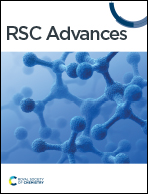Comparison of plasma technology for the study of herbicide degradation†
Abstract
The study aimed to investigate the effects of two different plasma systems, including pinhole plasma jet and gliding arc (GA) plasma, for the degradation of herbicide, diuron, in plasma activated solutions (PAS). In the GA plasma system, air was used to generate plasma, however, Ar, oxygen and nitrogen at different gas compositions were compared in the pinhole plasma jet system. The Taguchi design model was used to study the effects of gas compositions. Results revealed that the pinhole plasma jet system was able to degrade over 50% of the diuron in 60 minutes. The optimal plasma generation condition for the highest degradation of diuron used pure Ar gas. The highest degradation percentage of herbicide in PAS corresponded to the lowest hydrogen peroxide (H2O2) content, nitrite concentration and electrical conductivity (EC) of the PAS. The diuron degradation products were identified as 3,4-dichloro-benzenamine, 1-chloro-3-isocyanato-benzene and 1-chloro-4-isocyanato-benzene via gas chromatography-mass spectrometry (GC-MS). The GA plasma system was not adequate for the degradation of herbicide in PAS.



 Please wait while we load your content...
Please wait while we load your content...